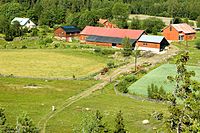
Photo from wikipedia
Vertical farming is the practice of growing crops vertically to increase total yield for a given space and is one approach toward sustainable food production. Concerns related with its operational… Click to show full abstract
Vertical farming is the practice of growing crops vertically to increase total yield for a given space and is one approach toward sustainable food production. Concerns related with its operational costs, and the need to optimize plant growth parameters in a controlled environment call for advanced use of Internet of Things (IoT) technologies to develop low-cost mechanisms for continuous monitoring and optimization of vertical farming processes. This article lays the groundwork for such mechanisms, providing an extensible, edge-centric architecture for IoT-supported autonomous vertical farm monitoring and management. We study alternative deployment strategies for it, exploring the design and performance implications of using LoRaWAN as the device connectivity substrate. We show experimentally that it is possible to handle vertical farm monitoring workloads corresponding to thousands of IoT devices, even when operating purely on minimal edge compute infrastructure, making it feasible to support the management of vertical farms cheaply and at scale.
Journal Title: IEEE Internet Computing
Year Published: 2022
Link to full text (if available)
Share on Social Media: Sign Up to like & get
recommendations!